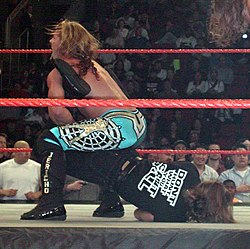Boston crab
This article needs additional citations for verification. (January 2009) |

The Boston crab is a professional wrestling hold that typically starts with the opponent lying supine on the mat, with the wrestler standing and facing them. It is a type of spinal lock where the wrestler hooks each of the opponent’s legs in one of his arms, and then turns the opponent face-down, stepping over him in the process. The final position has the wrestler in a semi-sitting position and facing away from his opponent, with the opponent’s back and legs bent back toward his face being very careful not to follow through. This often sees the attacking wrestler perform double leg takedown.
The original name for the maneuver was the backbreaker, before that term became known for its current usage. In modern wrestling, the Boston crab is not treated as a lethal submission maneuver, even though it was considered a match-ending hold in the past. In Japan, it is commonly used as a hold to defeat young and inexperienced wrestlers; the ability to overcome the hold is considered a sign of growth.
In submission grappling, the Boston crab (generally the half Boston crab) can be used to set up a straight ankle lock.[1]
Variations
Boston crab with knee
Similar to a normal Boston crab, this move sees the wrestler use a single knee to add additional pressure by pressing it into the opponent's back. An elevated variation also exists.
Boston crab with crossface
The attacking wrestler applies the boston crab and applies the crossface with his legs
Cross-legged Boston crab
This variation of a normal Boston crab sees the attacking wrestler get a hold of both of the opponent's feet, then crossing both legs over before tucking both legs under its same armpit (i.e. left leg under wrestler’s left armpit). After completing this, the attacking wrestler turns the opponent face-down, stepping over him/her in the process to secure the hold.
Elevated Boston crab
This move is best known as Chris Jericho's Walls of Jericho. Similar to a normal Boston Crab, this move sees the attacking wrestler stand farther back. The step-back allows additional pressure to be placed on the opponent's back from the higher angle, hence the name.
Inverted Boston crab
The wrestler grabs the legs of an opponent lying supine while standing over his opponent, steps in front of his opponents arms, and either remains standing or falls backwards, stretching the legs back. A single leg variation, also known as a Stump Puller, involves only one of the opponent's legs being stretched. This move can be used as a pin as well as a submission maneuver.
Reverse Boston crab
Not to be confused with the Inverted Boston crab, is executed by an aggressor standing over a face-down opponent facing in the same direction. From there the aggressor take each of his opponent's leg under each arm. With both legs under each armpit, he pushes down putting pressure on the knees & lower back of his opponent. A wrestler can also grab an opponent's arms, performing in effect a Reverse Rocking Horse, also known as Campana or Pendulum, this hold is highly popular in Mexico
Rocking horse
This Boston crab variation sees the wrestler lock the opponent in a standard version of the hold before lifting them off the ground by their arms (while still in the hold), and rocking them back and forth, putting additional pressure on their back.[2]
Single leg Boston crab
Also known as a half Boston crab or a half crab, a move that typically starts with the opponent on his/her back, and the attacking wrestler standing and facing them. The attacking wrestler hooks one of the opponent's legs in one of his/her arms, and then turns the opponent face-down, stepping over him in the process.
The final position has the dominant wrestler in a semi-sitting position and facing away from his/her opponent while the opponent is lying face-down and their own leg bent backwards toward his/her head. A variation with the attacking wrestler kneeling side-ways while having the leg hooked can be performed.
Single leg Boston crab with armlock
The attacking wrestler approaches a supine opponent and seizes one of their arms before walking around the opponent's head to their other side, thus forcing the opponent to roll onto their stomach. The wrestler then kneels on the back of the opponent, clinching the opponent's arm behind their knee, and applies a single leg Boston crab.
Tarantula

This move involves a wrestler hooking each of an opponent's legs in one of his/her arms and draping the opponent over the top rope, at this point the wrestler would hook the arms of the opponent with his/her legs securing the hold. As this move involves the use of the ropes, and allows the opponent to touch the ropes (which forces a wrestler to break a submission hold), this hold must usually be broken before the referee completes a five-count. Otherwise, the wrestler will be disqualified. This is the reason why it is best used during no disqualification matches or "I Quit" matches.
